Environmental Impact of Construction Materials: A Detailed Report
VerifiedAdded on 2020/10/04
|23
|9534
|456
Report
AI Summary
This report delves into the critical aspects of construction materials, addressing regulations, environmental impacts, and sustainability within the context of a hotel construction project. Task 1 examines the impact of regulations on the use, storage, and handling of construction materials, highlighting potential hazards and safety protocols as per OSHA guidelines. Task 2 focuses on environmental profiling and lifecycle assessments, evaluating the environmental impacts of materials like sand, brick, cement, and steel. It also discusses the benefits of product declaration and environmental certification. The report further presents results of relevant testing procedures to identify performance characteristics of selected construction materials (Task 3), followed by a material selection strategy considering human comfort and balanced indoor environments (Task 4). Furthermore, the report addresses risk assessments, waste management plans, and the effects of loading structural materials. It explores the application of multiple regulations, sustainable practices, and strategies to minimize energy, materials, water, and land use, concluding with an evaluation of passive and active strategies for environmental efficiency.

SCIENCE AND MATERIAL
Paraphrase This Document
Need a fresh take? Get an instant paraphrase of this document with our AI Paraphraser
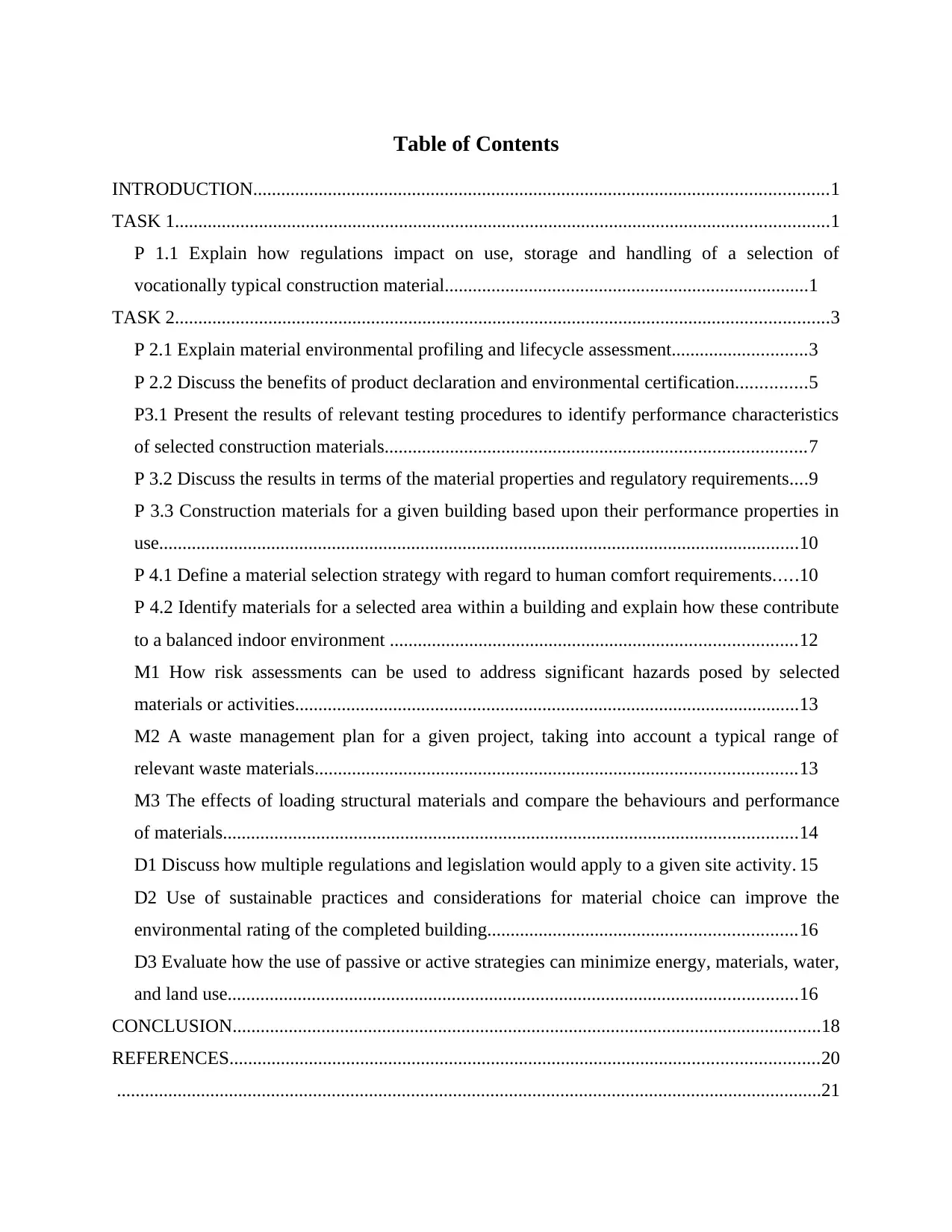
Table of Contents
INTRODUCTION...........................................................................................................................1
TASK 1............................................................................................................................................1
P 1.1 Explain how regulations impact on use, storage and handling of a selection of
vocationally typical construction material..............................................................................1
TASK 2............................................................................................................................................3
P 2.1 Explain material environmental profiling and lifecycle assessment.............................3
P 2.2 Discuss the benefits of product declaration and environmental certification...............5
P3.1 Present the results of relevant testing procedures to identify performance characteristics
of selected construction materials..........................................................................................7
P 3.2 Discuss the results in terms of the material properties and regulatory requirements....9
P 3.3 Construction materials for a given building based upon their performance properties in
use.........................................................................................................................................10
P 4.1 Define a material selection strategy with regard to human comfort requirements.....10
P 4.2 Identify materials for a selected area within a building and explain how these contribute
to a balanced indoor environment .......................................................................................12
M1 How risk assessments can be used to address significant hazards posed by selected
materials or activities............................................................................................................13
M2 A waste management plan for a given project, taking into account a typical range of
relevant waste materials.......................................................................................................13
M3 The effects of loading structural materials and compare the behaviours and performance
of materials...........................................................................................................................14
D1 Discuss how multiple regulations and legislation would apply to a given site activity. 15
D2 Use of sustainable practices and considerations for material choice can improve the
environmental rating of the completed building..................................................................16
D3 Evaluate how the use of passive or active strategies can minimize energy, materials, water,
and land use..........................................................................................................................16
CONCLUSION..............................................................................................................................18
REFERENCES..............................................................................................................................20
.......................................................................................................................................................21
INTRODUCTION...........................................................................................................................1
TASK 1............................................................................................................................................1
P 1.1 Explain how regulations impact on use, storage and handling of a selection of
vocationally typical construction material..............................................................................1
TASK 2............................................................................................................................................3
P 2.1 Explain material environmental profiling and lifecycle assessment.............................3
P 2.2 Discuss the benefits of product declaration and environmental certification...............5
P3.1 Present the results of relevant testing procedures to identify performance characteristics
of selected construction materials..........................................................................................7
P 3.2 Discuss the results in terms of the material properties and regulatory requirements....9
P 3.3 Construction materials for a given building based upon their performance properties in
use.........................................................................................................................................10
P 4.1 Define a material selection strategy with regard to human comfort requirements.....10
P 4.2 Identify materials for a selected area within a building and explain how these contribute
to a balanced indoor environment .......................................................................................12
M1 How risk assessments can be used to address significant hazards posed by selected
materials or activities............................................................................................................13
M2 A waste management plan for a given project, taking into account a typical range of
relevant waste materials.......................................................................................................13
M3 The effects of loading structural materials and compare the behaviours and performance
of materials...........................................................................................................................14
D1 Discuss how multiple regulations and legislation would apply to a given site activity. 15
D2 Use of sustainable practices and considerations for material choice can improve the
environmental rating of the completed building..................................................................16
D3 Evaluate how the use of passive or active strategies can minimize energy, materials, water,
and land use..........................................................................................................................16
CONCLUSION..............................................................................................................................18
REFERENCES..............................................................................................................................20
.......................................................................................................................................................21

⊘ This is a preview!⊘
Do you want full access?
Subscribe today to unlock all pages.

Trusted by 1+ million students worldwide
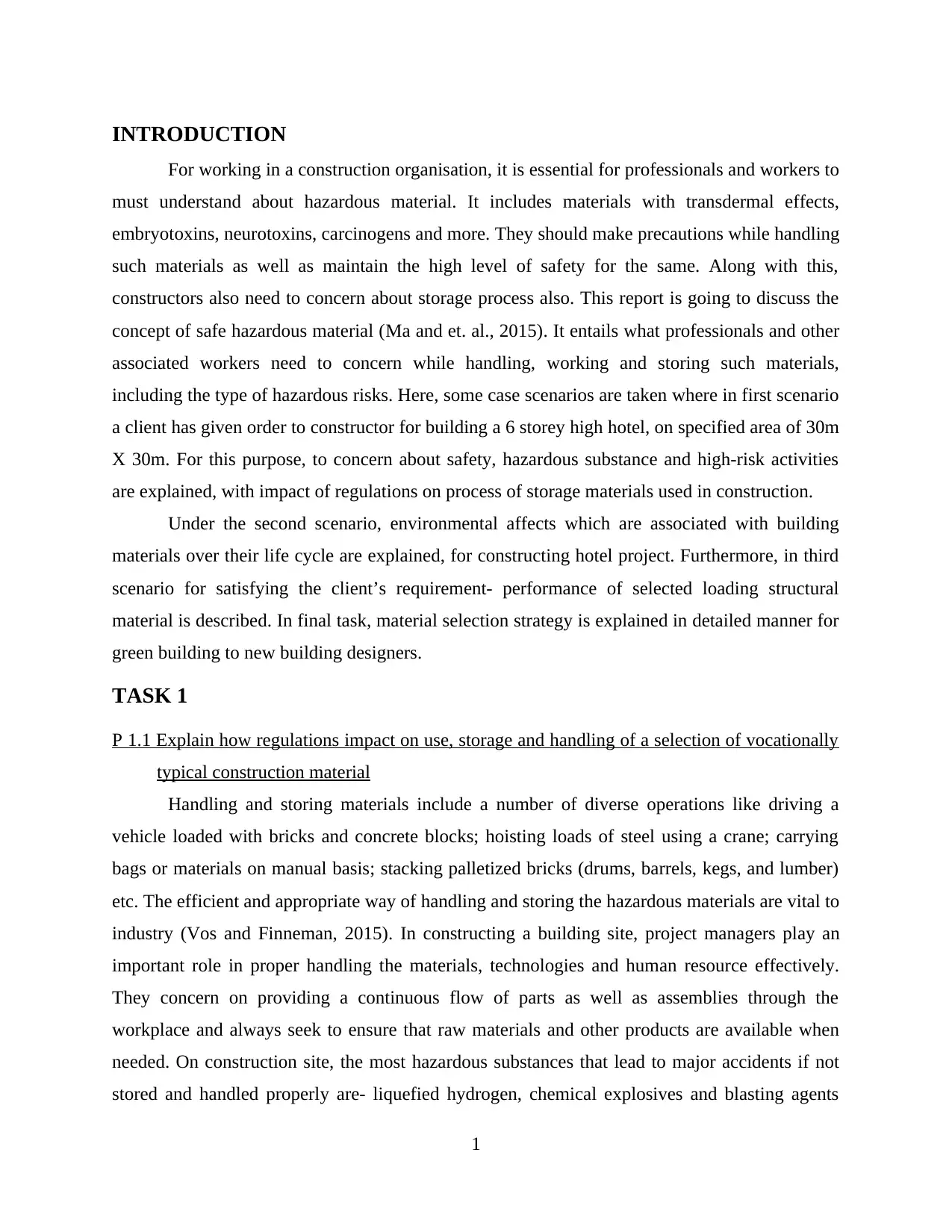
INTRODUCTION
For working in a construction organisation, it is essential for professionals and workers to
must understand about hazardous material. It includes materials with transdermal effects,
embryotoxins, neurotoxins, carcinogens and more. They should make precautions while handling
such materials as well as maintain the high level of safety for the same. Along with this,
constructors also need to concern about storage process also. This report is going to discuss the
concept of safe hazardous material (Ma and et. al., 2015). It entails what professionals and other
associated workers need to concern while handling, working and storing such materials,
including the type of hazardous risks. Here, some case scenarios are taken where in first scenario
a client has given order to constructor for building a 6 storey high hotel, on specified area of 30m
X 30m. For this purpose, to concern about safety, hazardous substance and high-risk activities
are explained, with impact of regulations on process of storage materials used in construction.
Under the second scenario, environmental affects which are associated with building
materials over their life cycle are explained, for constructing hotel project. Furthermore, in third
scenario for satisfying the client’s requirement- performance of selected loading structural
material is described. In final task, material selection strategy is explained in detailed manner for
green building to new building designers.
TASK 1
P 1.1 Explain how regulations impact on use, storage and handling of a selection of vocationally
typical construction material
Handling and storing materials include a number of diverse operations like driving a
vehicle loaded with bricks and concrete blocks; hoisting loads of steel using a crane; carrying
bags or materials on manual basis; stacking palletized bricks (drums, barrels, kegs, and lumber)
etc. The efficient and appropriate way of handling and storing the hazardous materials are vital to
industry (Vos and Finneman, 2015). In constructing a building site, project managers play an
important role in proper handling the materials, technologies and human resource effectively.
They concern on providing a continuous flow of parts as well as assemblies through the
workplace and always seek to ensure that raw materials and other products are available when
needed. On construction site, the most hazardous substances that lead to major accidents if not
stored and handled properly are- liquefied hydrogen, chemical explosives and blasting agents
1
For working in a construction organisation, it is essential for professionals and workers to
must understand about hazardous material. It includes materials with transdermal effects,
embryotoxins, neurotoxins, carcinogens and more. They should make precautions while handling
such materials as well as maintain the high level of safety for the same. Along with this,
constructors also need to concern about storage process also. This report is going to discuss the
concept of safe hazardous material (Ma and et. al., 2015). It entails what professionals and other
associated workers need to concern while handling, working and storing such materials,
including the type of hazardous risks. Here, some case scenarios are taken where in first scenario
a client has given order to constructor for building a 6 storey high hotel, on specified area of 30m
X 30m. For this purpose, to concern about safety, hazardous substance and high-risk activities
are explained, with impact of regulations on process of storage materials used in construction.
Under the second scenario, environmental affects which are associated with building
materials over their life cycle are explained, for constructing hotel project. Furthermore, in third
scenario for satisfying the client’s requirement- performance of selected loading structural
material is described. In final task, material selection strategy is explained in detailed manner for
green building to new building designers.
TASK 1
P 1.1 Explain how regulations impact on use, storage and handling of a selection of vocationally
typical construction material
Handling and storing materials include a number of diverse operations like driving a
vehicle loaded with bricks and concrete blocks; hoisting loads of steel using a crane; carrying
bags or materials on manual basis; stacking palletized bricks (drums, barrels, kegs, and lumber)
etc. The efficient and appropriate way of handling and storing the hazardous materials are vital to
industry (Vos and Finneman, 2015). In constructing a building site, project managers play an
important role in proper handling the materials, technologies and human resource effectively.
They concern on providing a continuous flow of parts as well as assemblies through the
workplace and always seek to ensure that raw materials and other products are available when
needed. On construction site, the most hazardous substances that lead to major accidents if not
stored and handled properly are- liquefied hydrogen, chemical explosives and blasting agents
1
Paraphrase This Document
Need a fresh take? Get an instant paraphrase of this document with our AI Paraphraser
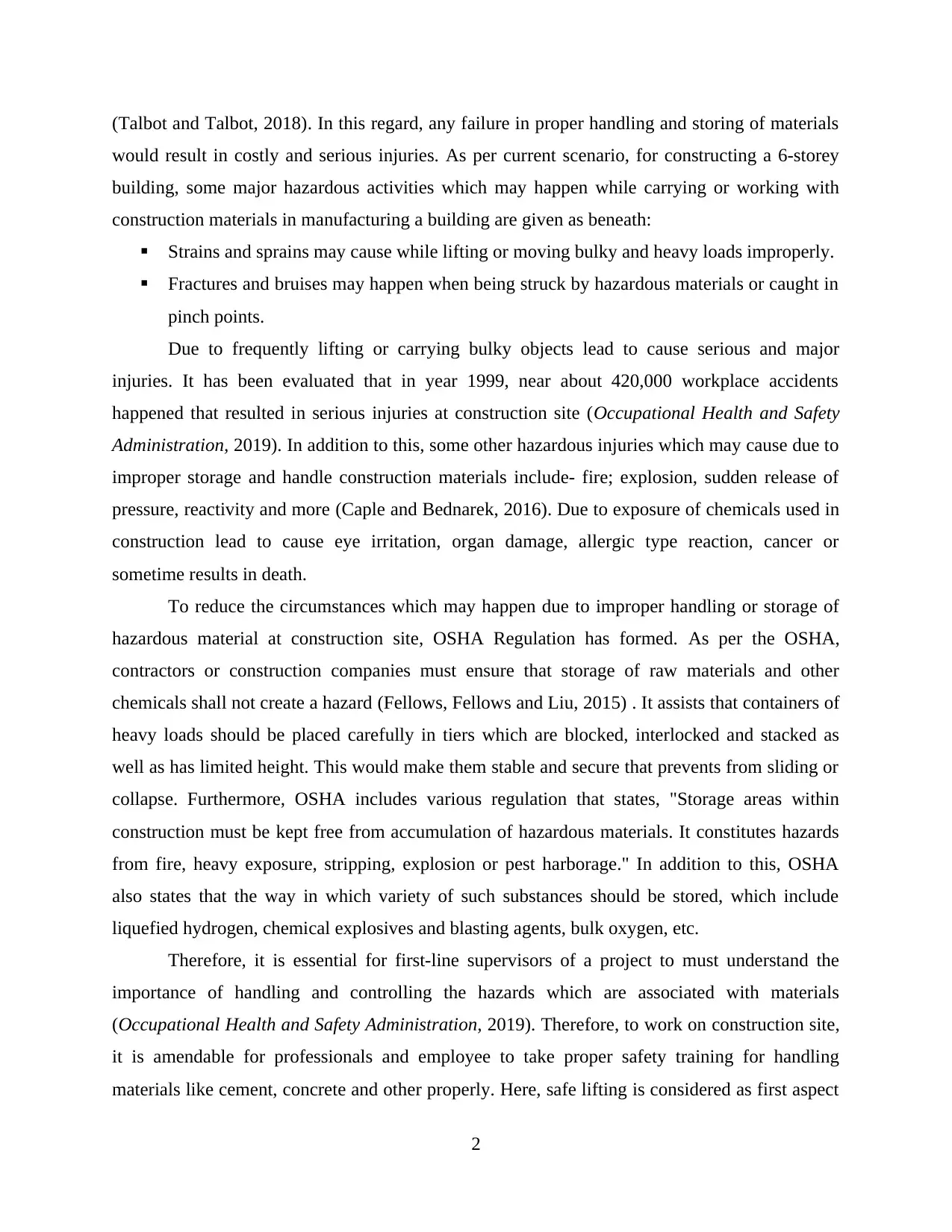
(Talbot and Talbot, 2018). In this regard, any failure in proper handling and storing of materials
would result in costly and serious injuries. As per current scenario, for constructing a 6-storey
building, some major hazardous activities which may happen while carrying or working with
construction materials in manufacturing a building are given as beneath:
Strains and sprains may cause while lifting or moving bulky and heavy loads improperly.
Fractures and bruises may happen when being struck by hazardous materials or caught in
pinch points.
Due to frequently lifting or carrying bulky objects lead to cause serious and major
injuries. It has been evaluated that in year 1999, near about 420,000 workplace accidents
happened that resulted in serious injuries at construction site (Occupational Health and Safety
Administration, 2019). In addition to this, some other hazardous injuries which may cause due to
improper storage and handle construction materials include- fire; explosion, sudden release of
pressure, reactivity and more (Caple and Bednarek, 2016). Due to exposure of chemicals used in
construction lead to cause eye irritation, organ damage, allergic type reaction, cancer or
sometime results in death.
To reduce the circumstances which may happen due to improper handling or storage of
hazardous material at construction site, OSHA Regulation has formed. As per the OSHA,
contractors or construction companies must ensure that storage of raw materials and other
chemicals shall not create a hazard (Fellows, Fellows and Liu, 2015) . It assists that containers of
heavy loads should be placed carefully in tiers which are blocked, interlocked and stacked as
well as has limited height. This would make them stable and secure that prevents from sliding or
collapse. Furthermore, OSHA includes various regulation that states, "Storage areas within
construction must be kept free from accumulation of hazardous materials. It constitutes hazards
from fire, heavy exposure, stripping, explosion or pest harborage." In addition to this, OSHA
also states that the way in which variety of such substances should be stored, which include
liquefied hydrogen, chemical explosives and blasting agents, bulk oxygen, etc.
Therefore, it is essential for first-line supervisors of a project to must understand the
importance of handling and controlling the hazards which are associated with materials
(Occupational Health and Safety Administration, 2019). Therefore, to work on construction site,
it is amendable for professionals and employee to take proper safety training for handling
materials like cement, concrete and other properly. Here, safe lifting is considered as first aspect
2
would result in costly and serious injuries. As per current scenario, for constructing a 6-storey
building, some major hazardous activities which may happen while carrying or working with
construction materials in manufacturing a building are given as beneath:
Strains and sprains may cause while lifting or moving bulky and heavy loads improperly.
Fractures and bruises may happen when being struck by hazardous materials or caught in
pinch points.
Due to frequently lifting or carrying bulky objects lead to cause serious and major
injuries. It has been evaluated that in year 1999, near about 420,000 workplace accidents
happened that resulted in serious injuries at construction site (Occupational Health and Safety
Administration, 2019). In addition to this, some other hazardous injuries which may cause due to
improper storage and handle construction materials include- fire; explosion, sudden release of
pressure, reactivity and more (Caple and Bednarek, 2016). Due to exposure of chemicals used in
construction lead to cause eye irritation, organ damage, allergic type reaction, cancer or
sometime results in death.
To reduce the circumstances which may happen due to improper handling or storage of
hazardous material at construction site, OSHA Regulation has formed. As per the OSHA,
contractors or construction companies must ensure that storage of raw materials and other
chemicals shall not create a hazard (Fellows, Fellows and Liu, 2015) . It assists that containers of
heavy loads should be placed carefully in tiers which are blocked, interlocked and stacked as
well as has limited height. This would make them stable and secure that prevents from sliding or
collapse. Furthermore, OSHA includes various regulation that states, "Storage areas within
construction must be kept free from accumulation of hazardous materials. It constitutes hazards
from fire, heavy exposure, stripping, explosion or pest harborage." In addition to this, OSHA
also states that the way in which variety of such substances should be stored, which include
liquefied hydrogen, chemical explosives and blasting agents, bulk oxygen, etc.
Therefore, it is essential for first-line supervisors of a project to must understand the
importance of handling and controlling the hazards which are associated with materials
(Occupational Health and Safety Administration, 2019). Therefore, to work on construction site,
it is amendable for professionals and employee to take proper safety training for handling
materials like cement, concrete and other properly. Here, safe lifting is considered as first aspect
2
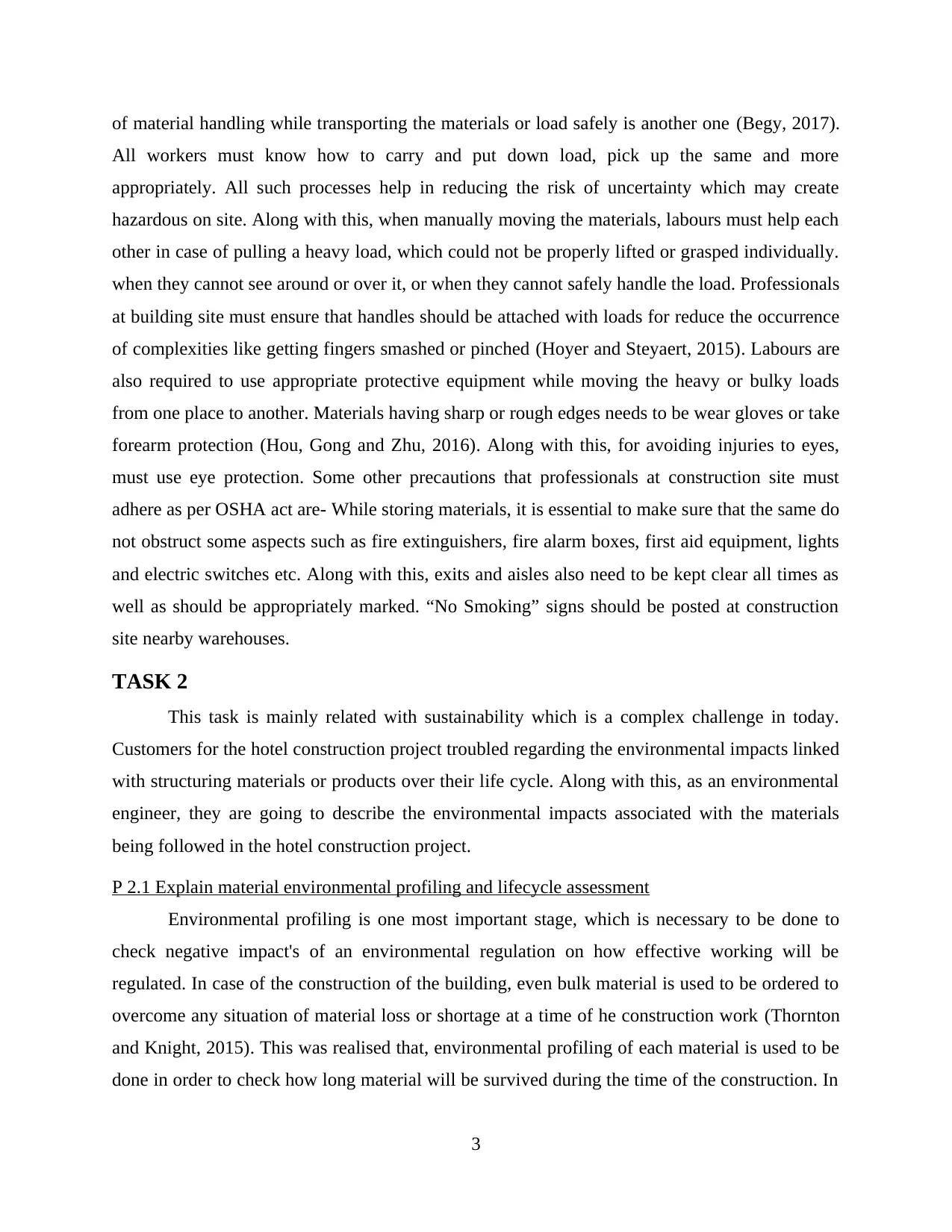
of material handling while transporting the materials or load safely is another one (Begy, 2017).
All workers must know how to carry and put down load, pick up the same and more
appropriately. All such processes help in reducing the risk of uncertainty which may create
hazardous on site. Along with this, when manually moving the materials, labours must help each
other in case of pulling a heavy load, which could not be properly lifted or grasped individually.
when they cannot see around or over it, or when they cannot safely handle the load. Professionals
at building site must ensure that handles should be attached with loads for reduce the occurrence
of complexities like getting fingers smashed or pinched (Hoyer and Steyaert, 2015). Labours are
also required to use appropriate protective equipment while moving the heavy or bulky loads
from one place to another. Materials having sharp or rough edges needs to be wear gloves or take
forearm protection (Hou, Gong and Zhu, 2016). Along with this, for avoiding injuries to eyes,
must use eye protection. Some other precautions that professionals at construction site must
adhere as per OSHA act are- While storing materials, it is essential to make sure that the same do
not obstruct some aspects such as fire extinguishers, fire alarm boxes, first aid equipment, lights
and electric switches etc. Along with this, exits and aisles also need to be kept clear all times as
well as should be appropriately marked. “No Smoking” signs should be posted at construction
site nearby warehouses.
TASK 2
This task is mainly related with sustainability which is a complex challenge in today.
Customers for the hotel construction project troubled regarding the environmental impacts linked
with structuring materials or products over their life cycle. Along with this, as an environmental
engineer, they are going to describe the environmental impacts associated with the materials
being followed in the hotel construction project.
P 2.1 Explain material environmental profiling and lifecycle assessment
Environmental profiling is one most important stage, which is necessary to be done to
check negative impact's of an environmental regulation on how effective working will be
regulated. In case of the construction of the building, even bulk material is used to be ordered to
overcome any situation of material loss or shortage at a time of he construction work (Thornton
and Knight, 2015). This was realised that, environmental profiling of each material is used to be
done in order to check how long material will be survived during the time of the construction. In
3
All workers must know how to carry and put down load, pick up the same and more
appropriately. All such processes help in reducing the risk of uncertainty which may create
hazardous on site. Along with this, when manually moving the materials, labours must help each
other in case of pulling a heavy load, which could not be properly lifted or grasped individually.
when they cannot see around or over it, or when they cannot safely handle the load. Professionals
at building site must ensure that handles should be attached with loads for reduce the occurrence
of complexities like getting fingers smashed or pinched (Hoyer and Steyaert, 2015). Labours are
also required to use appropriate protective equipment while moving the heavy or bulky loads
from one place to another. Materials having sharp or rough edges needs to be wear gloves or take
forearm protection (Hou, Gong and Zhu, 2016). Along with this, for avoiding injuries to eyes,
must use eye protection. Some other precautions that professionals at construction site must
adhere as per OSHA act are- While storing materials, it is essential to make sure that the same do
not obstruct some aspects such as fire extinguishers, fire alarm boxes, first aid equipment, lights
and electric switches etc. Along with this, exits and aisles also need to be kept clear all times as
well as should be appropriately marked. “No Smoking” signs should be posted at construction
site nearby warehouses.
TASK 2
This task is mainly related with sustainability which is a complex challenge in today.
Customers for the hotel construction project troubled regarding the environmental impacts linked
with structuring materials or products over their life cycle. Along with this, as an environmental
engineer, they are going to describe the environmental impacts associated with the materials
being followed in the hotel construction project.
P 2.1 Explain material environmental profiling and lifecycle assessment
Environmental profiling is one most important stage, which is necessary to be done to
check negative impact's of an environmental regulation on how effective working will be
regulated. In case of the construction of the building, even bulk material is used to be ordered to
overcome any situation of material loss or shortage at a time of he construction work (Thornton
and Knight, 2015). This was realised that, environmental profiling of each material is used to be
done in order to check how long material will be survived during the time of the construction. In
3
⊘ This is a preview!⊘
Do you want full access?
Subscribe today to unlock all pages.

Trusted by 1+ million students worldwide
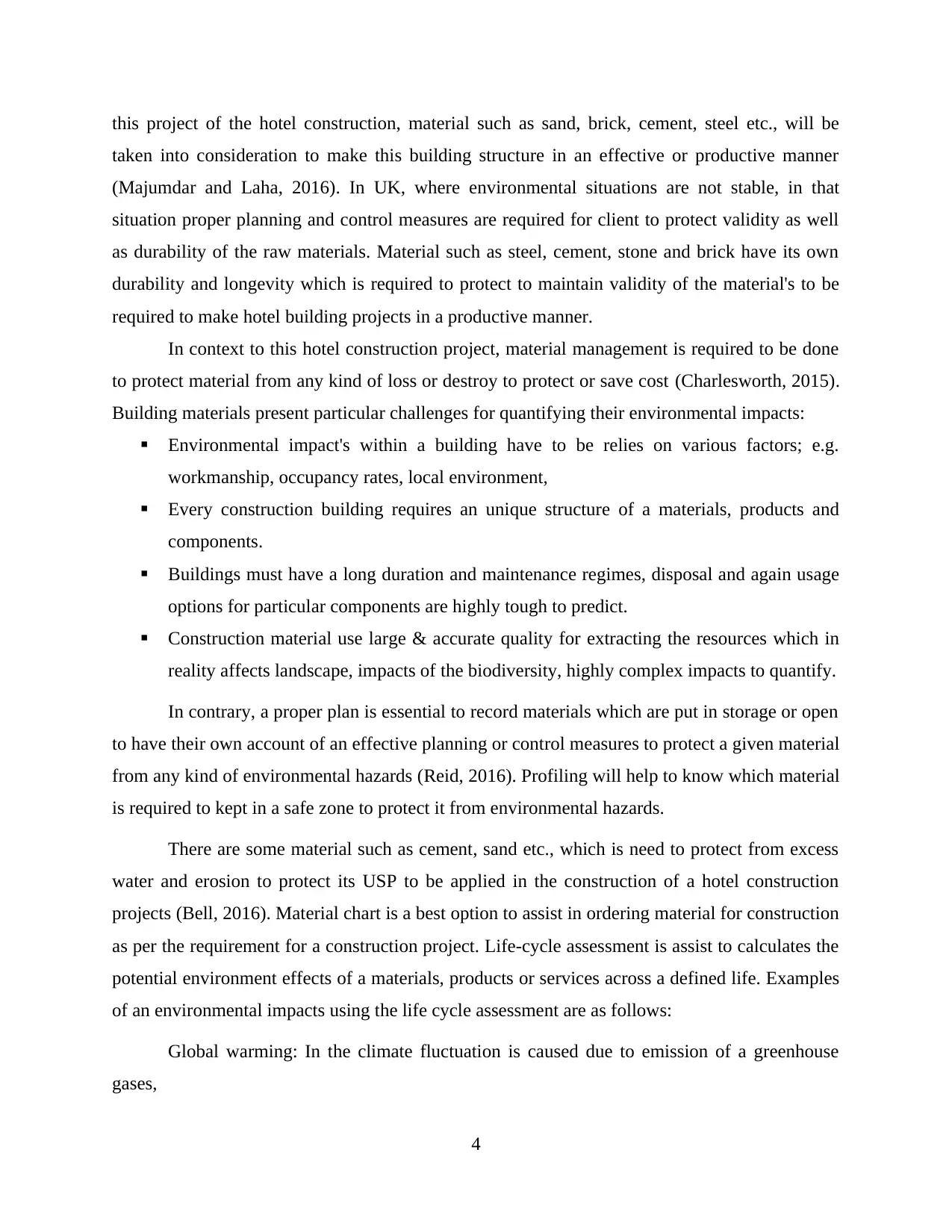
this project of the hotel construction, material such as sand, brick, cement, steel etc., will be
taken into consideration to make this building structure in an effective or productive manner
(Majumdar and Laha, 2016). In UK, where environmental situations are not stable, in that
situation proper planning and control measures are required for client to protect validity as well
as durability of the raw materials. Material such as steel, cement, stone and brick have its own
durability and longevity which is required to protect to maintain validity of the material's to be
required to make hotel building projects in a productive manner.
In context to this hotel construction project, material management is required to be done
to protect material from any kind of loss or destroy to protect or save cost (Charlesworth, 2015).
Building materials present particular challenges for quantifying their environmental impacts:
Environmental impact's within a building have to be relies on various factors; e.g.
workmanship, occupancy rates, local environment,
Every construction building requires an unique structure of a materials, products and
components.
Buildings must have a long duration and maintenance regimes, disposal and again usage
options for particular components are highly tough to predict.
Construction material use large & accurate quality for extracting the resources which in
reality affects landscape, impacts of the biodiversity, highly complex impacts to quantify.
In contrary, a proper plan is essential to record materials which are put in storage or open
to have their own account of an effective planning or control measures to protect a given material
from any kind of environmental hazards (Reid, 2016). Profiling will help to know which material
is required to kept in a safe zone to protect it from environmental hazards.
There are some material such as cement, sand etc., which is need to protect from excess
water and erosion to protect its USP to be applied in the construction of a hotel construction
projects (Bell, 2016). Material chart is a best option to assist in ordering material for construction
as per the requirement for a construction project. Life-cycle assessment is assist to calculates the
potential environment effects of a materials, products or services across a defined life. Examples
of an environmental impacts using the life cycle assessment are as follows:
Global warming: In the climate fluctuation is caused due to emission of a greenhouse
gases,
4
taken into consideration to make this building structure in an effective or productive manner
(Majumdar and Laha, 2016). In UK, where environmental situations are not stable, in that
situation proper planning and control measures are required for client to protect validity as well
as durability of the raw materials. Material such as steel, cement, stone and brick have its own
durability and longevity which is required to protect to maintain validity of the material's to be
required to make hotel building projects in a productive manner.
In context to this hotel construction project, material management is required to be done
to protect material from any kind of loss or destroy to protect or save cost (Charlesworth, 2015).
Building materials present particular challenges for quantifying their environmental impacts:
Environmental impact's within a building have to be relies on various factors; e.g.
workmanship, occupancy rates, local environment,
Every construction building requires an unique structure of a materials, products and
components.
Buildings must have a long duration and maintenance regimes, disposal and again usage
options for particular components are highly tough to predict.
Construction material use large & accurate quality for extracting the resources which in
reality affects landscape, impacts of the biodiversity, highly complex impacts to quantify.
In contrary, a proper plan is essential to record materials which are put in storage or open
to have their own account of an effective planning or control measures to protect a given material
from any kind of environmental hazards (Reid, 2016). Profiling will help to know which material
is required to kept in a safe zone to protect it from environmental hazards.
There are some material such as cement, sand etc., which is need to protect from excess
water and erosion to protect its USP to be applied in the construction of a hotel construction
projects (Bell, 2016). Material chart is a best option to assist in ordering material for construction
as per the requirement for a construction project. Life-cycle assessment is assist to calculates the
potential environment effects of a materials, products or services across a defined life. Examples
of an environmental impacts using the life cycle assessment are as follows:
Global warming: In the climate fluctuation is caused due to emission of a greenhouse
gases,
4
Paraphrase This Document
Need a fresh take? Get an instant paraphrase of this document with our AI Paraphraser
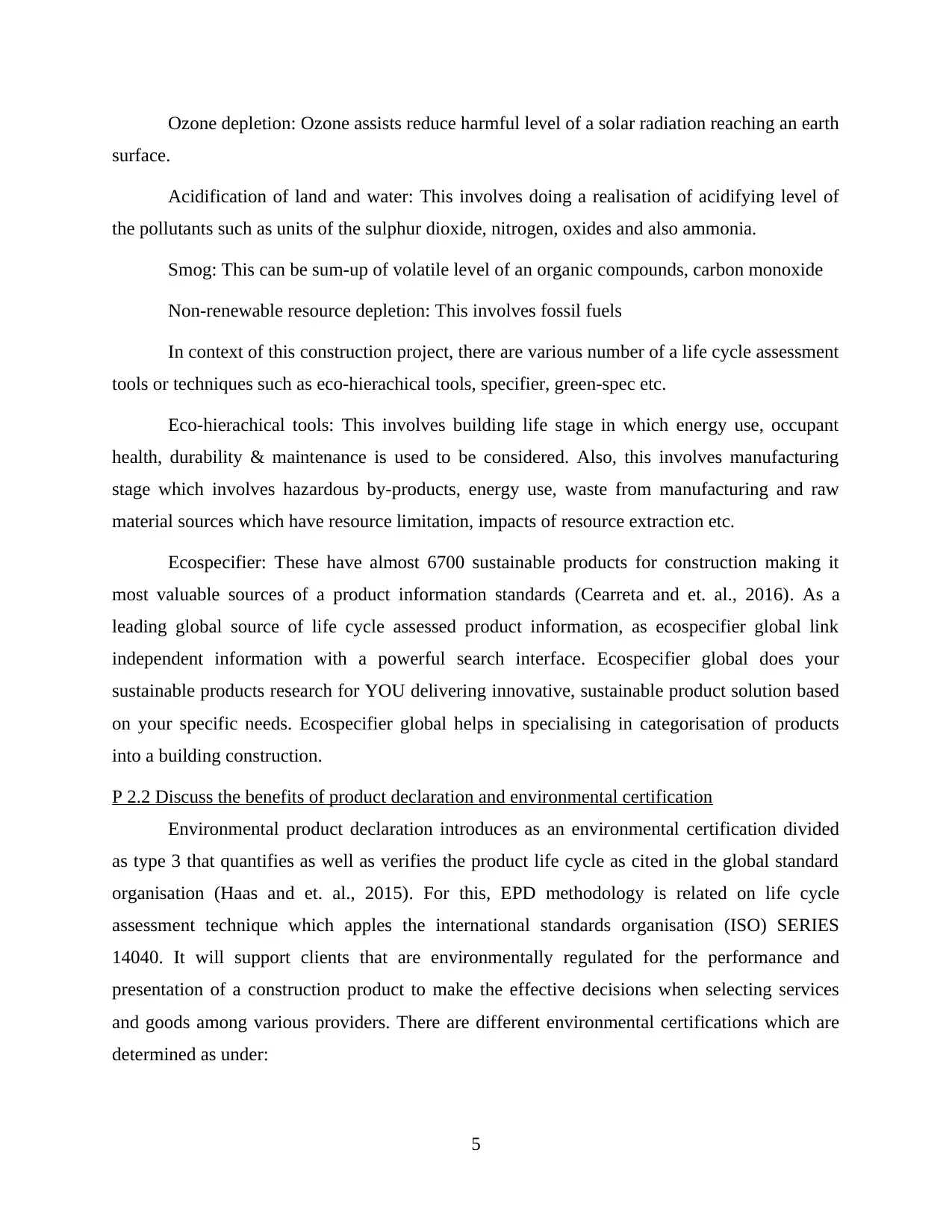
Ozone depletion: Ozone assists reduce harmful level of a solar radiation reaching an earth
surface.
Acidification of land and water: This involves doing a realisation of acidifying level of
the pollutants such as units of the sulphur dioxide, nitrogen, oxides and also ammonia.
Smog: This can be sum-up of volatile level of an organic compounds, carbon monoxide
Non-renewable resource depletion: This involves fossil fuels
In context of this construction project, there are various number of a life cycle assessment
tools or techniques such as eco-hierachical tools, specifier, green-spec etc.
Eco-hierachical tools: This involves building life stage in which energy use, occupant
health, durability & maintenance is used to be considered. Also, this involves manufacturing
stage which involves hazardous by-products, energy use, waste from manufacturing and raw
material sources which have resource limitation, impacts of resource extraction etc.
Ecospecifier: These have almost 6700 sustainable products for construction making it
most valuable sources of a product information standards (Cearreta and et. al., 2016). As a
leading global source of life cycle assessed product information, as ecospecifier global link
independent information with a powerful search interface. Ecospecifier global does your
sustainable products research for YOU delivering innovative, sustainable product solution based
on your specific needs. Ecospecifier global helps in specialising in categorisation of products
into a building construction.
P 2.2 Discuss the benefits of product declaration and environmental certification
Environmental product declaration introduces as an environmental certification divided
as type 3 that quantifies as well as verifies the product life cycle as cited in the global standard
organisation (Haas and et. al., 2015). For this, EPD methodology is related on life cycle
assessment technique which apples the international standards organisation (ISO) SERIES
14040. It will support clients that are environmentally regulated for the performance and
presentation of a construction product to make the effective decisions when selecting services
and goods among various providers. There are different environmental certifications which are
determined as under:
5
surface.
Acidification of land and water: This involves doing a realisation of acidifying level of
the pollutants such as units of the sulphur dioxide, nitrogen, oxides and also ammonia.
Smog: This can be sum-up of volatile level of an organic compounds, carbon monoxide
Non-renewable resource depletion: This involves fossil fuels
In context of this construction project, there are various number of a life cycle assessment
tools or techniques such as eco-hierachical tools, specifier, green-spec etc.
Eco-hierachical tools: This involves building life stage in which energy use, occupant
health, durability & maintenance is used to be considered. Also, this involves manufacturing
stage which involves hazardous by-products, energy use, waste from manufacturing and raw
material sources which have resource limitation, impacts of resource extraction etc.
Ecospecifier: These have almost 6700 sustainable products for construction making it
most valuable sources of a product information standards (Cearreta and et. al., 2016). As a
leading global source of life cycle assessed product information, as ecospecifier global link
independent information with a powerful search interface. Ecospecifier global does your
sustainable products research for YOU delivering innovative, sustainable product solution based
on your specific needs. Ecospecifier global helps in specialising in categorisation of products
into a building construction.
P 2.2 Discuss the benefits of product declaration and environmental certification
Environmental product declaration introduces as an environmental certification divided
as type 3 that quantifies as well as verifies the product life cycle as cited in the global standard
organisation (Haas and et. al., 2015). For this, EPD methodology is related on life cycle
assessment technique which apples the international standards organisation (ISO) SERIES
14040. It will support clients that are environmentally regulated for the performance and
presentation of a construction product to make the effective decisions when selecting services
and goods among various providers. There are different environmental certifications which are
determined as under:
5
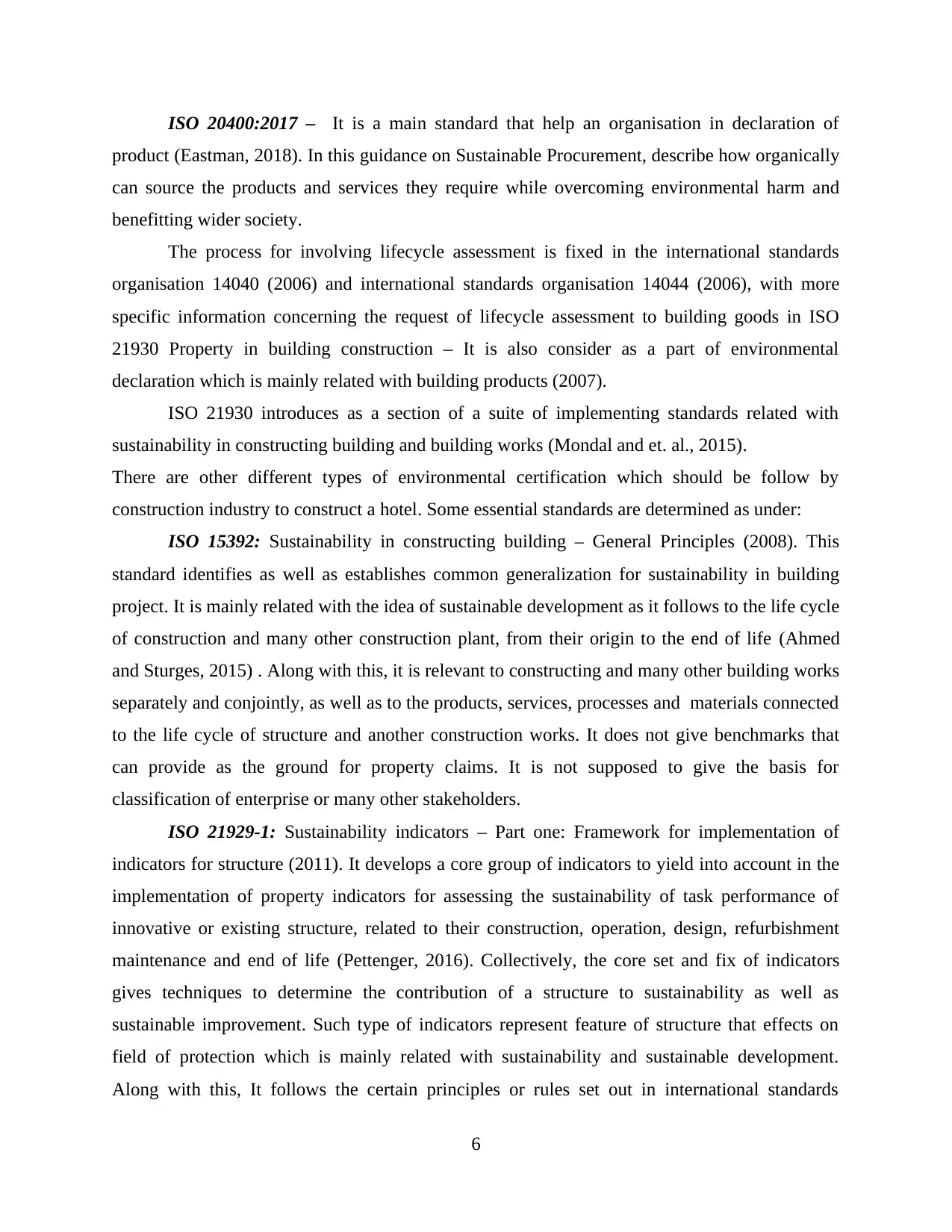
ISO 20400:2017 – It is a main standard that help an organisation in declaration of
product (Eastman, 2018). In this guidance on Sustainable Procurement, describe how organically
can source the products and services they require while overcoming environmental harm and
benefitting wider society.
The process for involving lifecycle assessment is fixed in the international standards
organisation 14040 (2006) and international standards organisation 14044 (2006), with more
specific information concerning the request of lifecycle assessment to building goods in ISO
21930 Property in building construction – It is also consider as a part of environmental
declaration which is mainly related with building products (2007).
ISO 21930 introduces as a section of a suite of implementing standards related with
sustainability in constructing building and building works (Mondal and et. al., 2015).
There are other different types of environmental certification which should be follow by
construction industry to construct a hotel. Some essential standards are determined as under:
ISO 15392: Sustainability in constructing building – General Principles (2008). This
standard identifies as well as establishes common generalization for sustainability in building
project. It is mainly related with the idea of sustainable development as it follows to the life cycle
of construction and many other construction plant, from their origin to the end of life (Ahmed
and Sturges, 2015) . Along with this, it is relevant to constructing and many other building works
separately and conjointly, as well as to the products, services, processes and materials connected
to the life cycle of structure and another construction works. It does not give benchmarks that
can provide as the ground for property claims. It is not supposed to give the basis for
classification of enterprise or many other stakeholders.
ISO 21929-1: Sustainability indicators – Part one: Framework for implementation of
indicators for structure (2011). It develops a core group of indicators to yield into account in the
implementation of property indicators for assessing the sustainability of task performance of
innovative or existing structure, related to their construction, operation, design, refurbishment
maintenance and end of life (Pettenger, 2016). Collectively, the core set and fix of indicators
gives techniques to determine the contribution of a structure to sustainability as well as
sustainable improvement. Such type of indicators represent feature of structure that effects on
field of protection which is mainly related with sustainability and sustainable development.
Along with this, It follows the certain principles or rules set out in international standards
6
product (Eastman, 2018). In this guidance on Sustainable Procurement, describe how organically
can source the products and services they require while overcoming environmental harm and
benefitting wider society.
The process for involving lifecycle assessment is fixed in the international standards
organisation 14040 (2006) and international standards organisation 14044 (2006), with more
specific information concerning the request of lifecycle assessment to building goods in ISO
21930 Property in building construction – It is also consider as a part of environmental
declaration which is mainly related with building products (2007).
ISO 21930 introduces as a section of a suite of implementing standards related with
sustainability in constructing building and building works (Mondal and et. al., 2015).
There are other different types of environmental certification which should be follow by
construction industry to construct a hotel. Some essential standards are determined as under:
ISO 15392: Sustainability in constructing building – General Principles (2008). This
standard identifies as well as establishes common generalization for sustainability in building
project. It is mainly related with the idea of sustainable development as it follows to the life cycle
of construction and many other construction plant, from their origin to the end of life (Ahmed
and Sturges, 2015) . Along with this, it is relevant to constructing and many other building works
separately and conjointly, as well as to the products, services, processes and materials connected
to the life cycle of structure and another construction works. It does not give benchmarks that
can provide as the ground for property claims. It is not supposed to give the basis for
classification of enterprise or many other stakeholders.
ISO 21929-1: Sustainability indicators – Part one: Framework for implementation of
indicators for structure (2011). It develops a core group of indicators to yield into account in the
implementation of property indicators for assessing the sustainability of task performance of
innovative or existing structure, related to their construction, operation, design, refurbishment
maintenance and end of life (Pettenger, 2016). Collectively, the core set and fix of indicators
gives techniques to determine the contribution of a structure to sustainability as well as
sustainable improvement. Such type of indicators represent feature of structure that effects on
field of protection which is mainly related with sustainability and sustainable development.
Along with this, It follows the certain principles or rules set out in international standards
6
⊘ This is a preview!⊘
Do you want full access?
Subscribe today to unlock all pages.

Trusted by 1+ million students worldwide
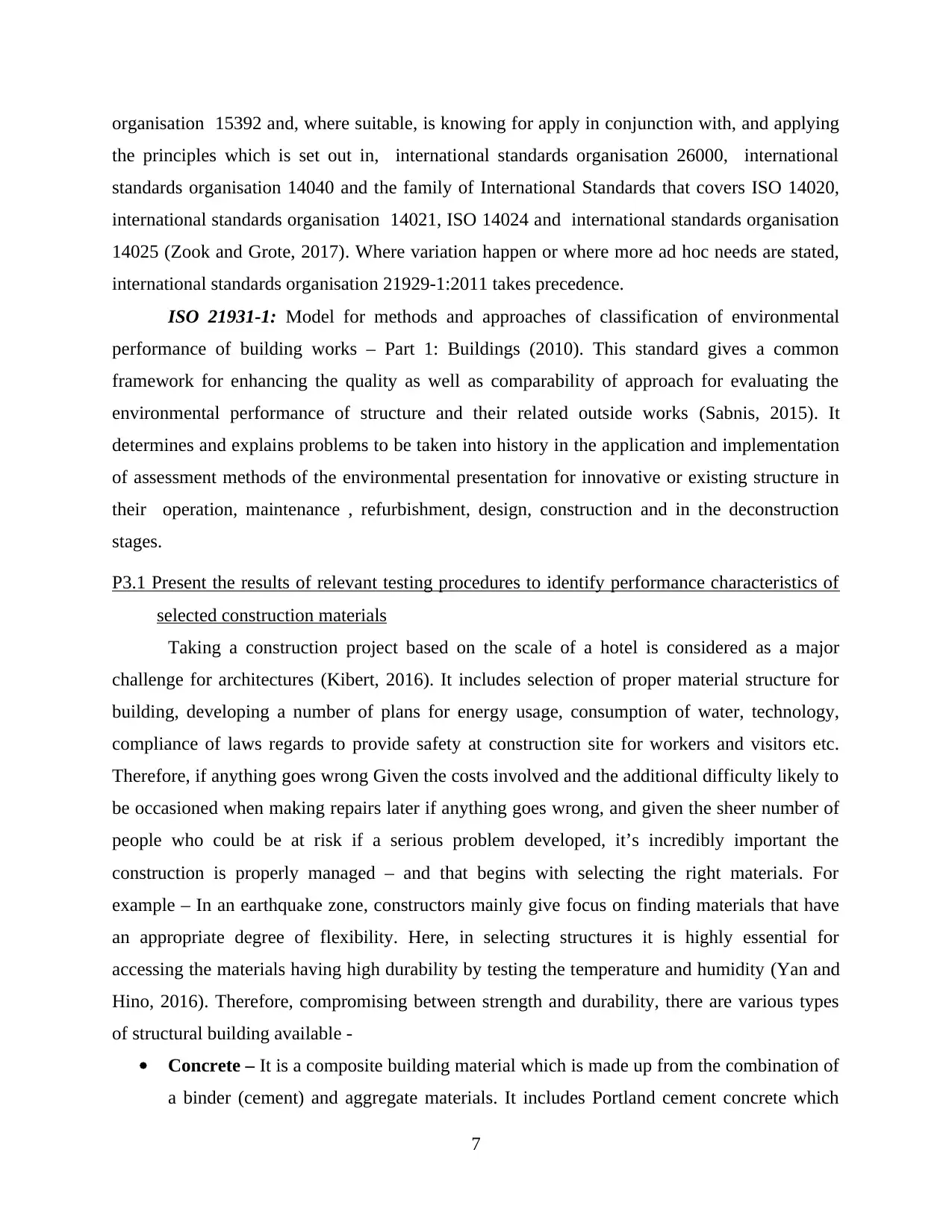
organisation 15392 and, where suitable, is knowing for apply in conjunction with, and applying
the principles which is set out in, international standards organisation 26000, international
standards organisation 14040 and the family of International Standards that covers ISO 14020,
international standards organisation 14021, ISO 14024 and international standards organisation
14025 (Zook and Grote, 2017). Where variation happen or where more ad hoc needs are stated,
international standards organisation 21929-1:2011 takes precedence.
ISO 21931-1: Model for methods and approaches of classification of environmental
performance of building works – Part 1: Buildings (2010). This standard gives a common
framework for enhancing the quality as well as comparability of approach for evaluating the
environmental performance of structure and their related outside works (Sabnis, 2015). It
determines and explains problems to be taken into history in the application and implementation
of assessment methods of the environmental presentation for innovative or existing structure in
their operation, maintenance , refurbishment, design, construction and in the deconstruction
stages.
P3.1 Present the results of relevant testing procedures to identify performance characteristics of
selected construction materials
Taking a construction project based on the scale of a hotel is considered as a major
challenge for architectures (Kibert, 2016). It includes selection of proper material structure for
building, developing a number of plans for energy usage, consumption of water, technology,
compliance of laws regards to provide safety at construction site for workers and visitors etc.
Therefore, if anything goes wrong Given the costs involved and the additional difficulty likely to
be occasioned when making repairs later if anything goes wrong, and given the sheer number of
people who could be at risk if a serious problem developed, it’s incredibly important the
construction is properly managed – and that begins with selecting the right materials. For
example – In an earthquake zone, constructors mainly give focus on finding materials that have
an appropriate degree of flexibility. Here, in selecting structures it is highly essential for
accessing the materials having high durability by testing the temperature and humidity (Yan and
Hino, 2016). Therefore, compromising between strength and durability, there are various types
of structural building available -
Concrete – It is a composite building material which is made up from the combination of
a binder (cement) and aggregate materials. It includes Portland cement concrete which
7
the principles which is set out in, international standards organisation 26000, international
standards organisation 14040 and the family of International Standards that covers ISO 14020,
international standards organisation 14021, ISO 14024 and international standards organisation
14025 (Zook and Grote, 2017). Where variation happen or where more ad hoc needs are stated,
international standards organisation 21929-1:2011 takes precedence.
ISO 21931-1: Model for methods and approaches of classification of environmental
performance of building works – Part 1: Buildings (2010). This standard gives a common
framework for enhancing the quality as well as comparability of approach for evaluating the
environmental performance of structure and their related outside works (Sabnis, 2015). It
determines and explains problems to be taken into history in the application and implementation
of assessment methods of the environmental presentation for innovative or existing structure in
their operation, maintenance , refurbishment, design, construction and in the deconstruction
stages.
P3.1 Present the results of relevant testing procedures to identify performance characteristics of
selected construction materials
Taking a construction project based on the scale of a hotel is considered as a major
challenge for architectures (Kibert, 2016). It includes selection of proper material structure for
building, developing a number of plans for energy usage, consumption of water, technology,
compliance of laws regards to provide safety at construction site for workers and visitors etc.
Therefore, if anything goes wrong Given the costs involved and the additional difficulty likely to
be occasioned when making repairs later if anything goes wrong, and given the sheer number of
people who could be at risk if a serious problem developed, it’s incredibly important the
construction is properly managed – and that begins with selecting the right materials. For
example – In an earthquake zone, constructors mainly give focus on finding materials that have
an appropriate degree of flexibility. Here, in selecting structures it is highly essential for
accessing the materials having high durability by testing the temperature and humidity (Yan and
Hino, 2016). Therefore, compromising between strength and durability, there are various types
of structural building available -
Concrete – It is a composite building material which is made up from the combination of
a binder (cement) and aggregate materials. It includes Portland cement concrete which
7
Paraphrase This Document
Need a fresh take? Get an instant paraphrase of this document with our AI Paraphraser
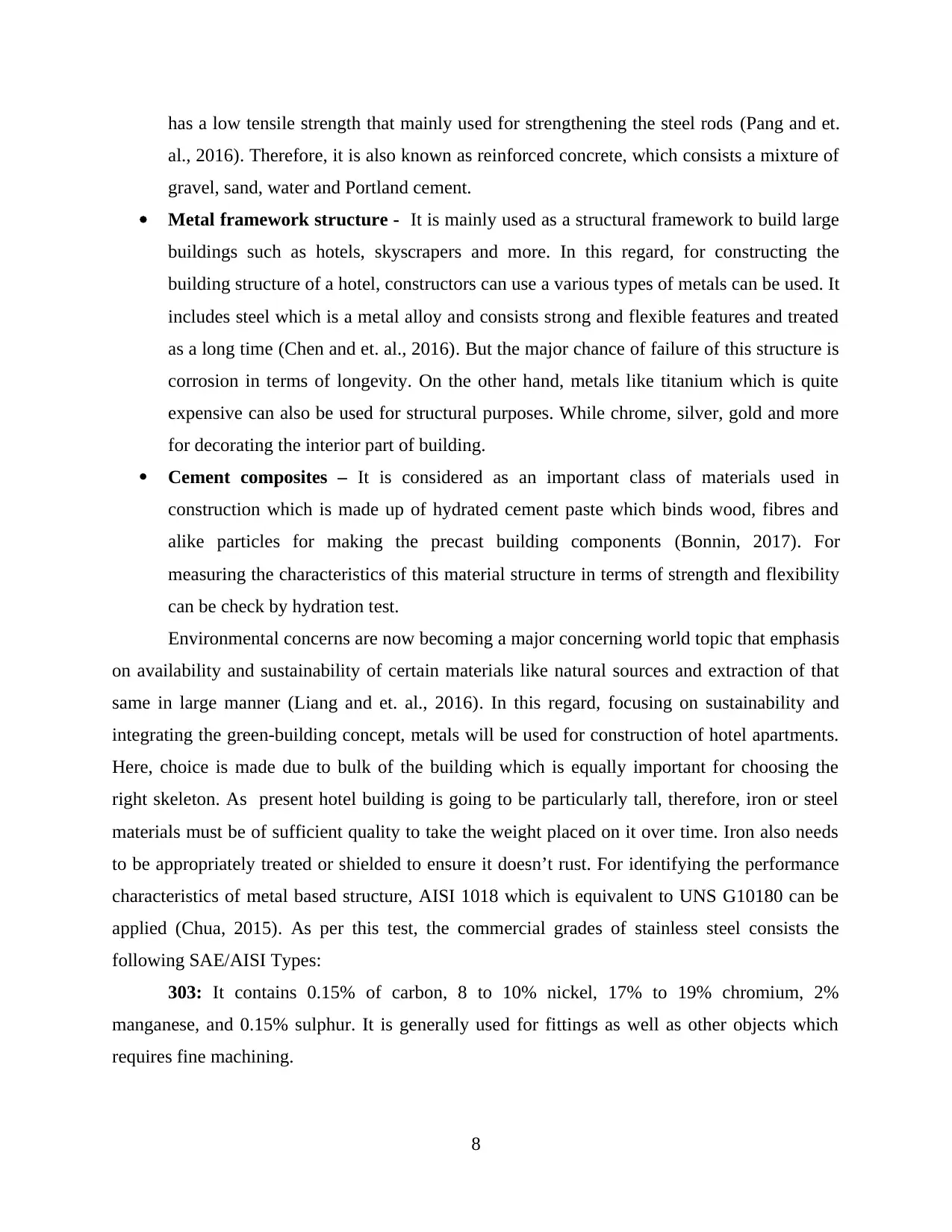
has a low tensile strength that mainly used for strengthening the steel rods (Pang and et.
al., 2016). Therefore, it is also known as reinforced concrete, which consists a mixture of
gravel, sand, water and Portland cement.
Metal framework structure - It is mainly used as a structural framework to build large
buildings such as hotels, skyscrapers and more. In this regard, for constructing the
building structure of a hotel, constructors can use a various types of metals can be used. It
includes steel which is a metal alloy and consists strong and flexible features and treated
as a long time (Chen and et. al., 2016). But the major chance of failure of this structure is
corrosion in terms of longevity. On the other hand, metals like titanium which is quite
expensive can also be used for structural purposes. While chrome, silver, gold and more
for decorating the interior part of building.
Cement composites – It is considered as an important class of materials used in
construction which is made up of hydrated cement paste which binds wood, fibres and
alike particles for making the precast building components (Bonnin, 2017). For
measuring the characteristics of this material structure in terms of strength and flexibility
can be check by hydration test.
Environmental concerns are now becoming a major concerning world topic that emphasis
on availability and sustainability of certain materials like natural sources and extraction of that
same in large manner (Liang and et. al., 2016). In this regard, focusing on sustainability and
integrating the green-building concept, metals will be used for construction of hotel apartments.
Here, choice is made due to bulk of the building which is equally important for choosing the
right skeleton. As present hotel building is going to be particularly tall, therefore, iron or steel
materials must be of sufficient quality to take the weight placed on it over time. Iron also needs
to be appropriately treated or shielded to ensure it doesn’t rust. For identifying the performance
characteristics of metal based structure, AISI 1018 which is equivalent to UNS G10180 can be
applied (Chua, 2015). As per this test, the commercial grades of stainless steel consists the
following SAE/AISI Types:
303: It contains 0.15% of carbon, 8 to 10% nickel, 17% to 19% chromium, 2%
manganese, and 0.15% sulphur. It is generally used for fittings as well as other objects which
requires fine machining.
8
al., 2016). Therefore, it is also known as reinforced concrete, which consists a mixture of
gravel, sand, water and Portland cement.
Metal framework structure - It is mainly used as a structural framework to build large
buildings such as hotels, skyscrapers and more. In this regard, for constructing the
building structure of a hotel, constructors can use a various types of metals can be used. It
includes steel which is a metal alloy and consists strong and flexible features and treated
as a long time (Chen and et. al., 2016). But the major chance of failure of this structure is
corrosion in terms of longevity. On the other hand, metals like titanium which is quite
expensive can also be used for structural purposes. While chrome, silver, gold and more
for decorating the interior part of building.
Cement composites – It is considered as an important class of materials used in
construction which is made up of hydrated cement paste which binds wood, fibres and
alike particles for making the precast building components (Bonnin, 2017). For
measuring the characteristics of this material structure in terms of strength and flexibility
can be check by hydration test.
Environmental concerns are now becoming a major concerning world topic that emphasis
on availability and sustainability of certain materials like natural sources and extraction of that
same in large manner (Liang and et. al., 2016). In this regard, focusing on sustainability and
integrating the green-building concept, metals will be used for construction of hotel apartments.
Here, choice is made due to bulk of the building which is equally important for choosing the
right skeleton. As present hotel building is going to be particularly tall, therefore, iron or steel
materials must be of sufficient quality to take the weight placed on it over time. Iron also needs
to be appropriately treated or shielded to ensure it doesn’t rust. For identifying the performance
characteristics of metal based structure, AISI 1018 which is equivalent to UNS G10180 can be
applied (Chua, 2015). As per this test, the commercial grades of stainless steel consists the
following SAE/AISI Types:
303: It contains 0.15% of carbon, 8 to 10% nickel, 17% to 19% chromium, 2%
manganese, and 0.15% sulphur. It is generally used for fittings as well as other objects which
requires fine machining.
8
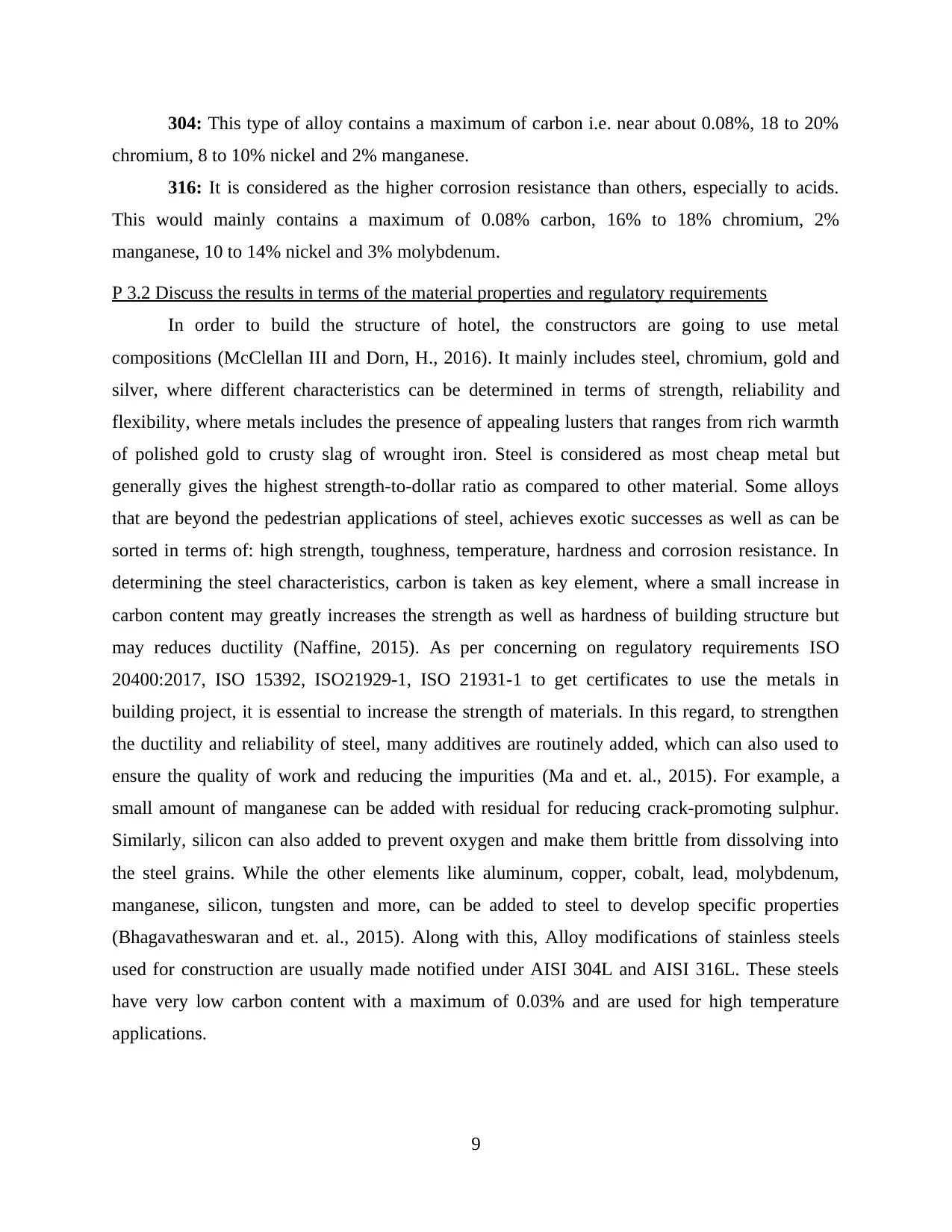
304: This type of alloy contains a maximum of carbon i.e. near about 0.08%, 18 to 20%
chromium, 8 to 10% nickel and 2% manganese.
316: It is considered as the higher corrosion resistance than others, especially to acids.
This would mainly contains a maximum of 0.08% carbon, 16% to 18% chromium, 2%
manganese, 10 to 14% nickel and 3% molybdenum.
P 3.2 Discuss the results in terms of the material properties and regulatory requirements
In order to build the structure of hotel, the constructors are going to use metal
compositions (McClellan III and Dorn, H., 2016). It mainly includes steel, chromium, gold and
silver, where different characteristics can be determined in terms of strength, reliability and
flexibility, where metals includes the presence of appealing lusters that ranges from rich warmth
of polished gold to crusty slag of wrought iron. Steel is considered as most cheap metal but
generally gives the highest strength-to-dollar ratio as compared to other material. Some alloys
that are beyond the pedestrian applications of steel, achieves exotic successes as well as can be
sorted in terms of: high strength, toughness, temperature, hardness and corrosion resistance. In
determining the steel characteristics, carbon is taken as key element, where a small increase in
carbon content may greatly increases the strength as well as hardness of building structure but
may reduces ductility (Naffine, 2015). As per concerning on regulatory requirements ISO
20400:2017, ISO 15392, ISO21929-1, ISO 21931-1 to get certificates to use the metals in
building project, it is essential to increase the strength of materials. In this regard, to strengthen
the ductility and reliability of steel, many additives are routinely added, which can also used to
ensure the quality of work and reducing the impurities (Ma and et. al., 2015). For example, a
small amount of manganese can be added with residual for reducing crack-promoting sulphur.
Similarly, silicon can also added to prevent oxygen and make them brittle from dissolving into
the steel grains. While the other elements like aluminum, copper, cobalt, lead, molybdenum,
manganese, silicon, tungsten and more, can be added to steel to develop specific properties
(Bhagavatheswaran and et. al., 2015). Along with this, Alloy modifications of stainless steels
used for construction are usually made notified under AISI 304L and AISI 316L. These steels
have very low carbon content with a maximum of 0.03% and are used for high temperature
applications.
9
chromium, 8 to 10% nickel and 2% manganese.
316: It is considered as the higher corrosion resistance than others, especially to acids.
This would mainly contains a maximum of 0.08% carbon, 16% to 18% chromium, 2%
manganese, 10 to 14% nickel and 3% molybdenum.
P 3.2 Discuss the results in terms of the material properties and regulatory requirements
In order to build the structure of hotel, the constructors are going to use metal
compositions (McClellan III and Dorn, H., 2016). It mainly includes steel, chromium, gold and
silver, where different characteristics can be determined in terms of strength, reliability and
flexibility, where metals includes the presence of appealing lusters that ranges from rich warmth
of polished gold to crusty slag of wrought iron. Steel is considered as most cheap metal but
generally gives the highest strength-to-dollar ratio as compared to other material. Some alloys
that are beyond the pedestrian applications of steel, achieves exotic successes as well as can be
sorted in terms of: high strength, toughness, temperature, hardness and corrosion resistance. In
determining the steel characteristics, carbon is taken as key element, where a small increase in
carbon content may greatly increases the strength as well as hardness of building structure but
may reduces ductility (Naffine, 2015). As per concerning on regulatory requirements ISO
20400:2017, ISO 15392, ISO21929-1, ISO 21931-1 to get certificates to use the metals in
building project, it is essential to increase the strength of materials. In this regard, to strengthen
the ductility and reliability of steel, many additives are routinely added, which can also used to
ensure the quality of work and reducing the impurities (Ma and et. al., 2015). For example, a
small amount of manganese can be added with residual for reducing crack-promoting sulphur.
Similarly, silicon can also added to prevent oxygen and make them brittle from dissolving into
the steel grains. While the other elements like aluminum, copper, cobalt, lead, molybdenum,
manganese, silicon, tungsten and more, can be added to steel to develop specific properties
(Bhagavatheswaran and et. al., 2015). Along with this, Alloy modifications of stainless steels
used for construction are usually made notified under AISI 304L and AISI 316L. These steels
have very low carbon content with a maximum of 0.03% and are used for high temperature
applications.
9
⊘ This is a preview!⊘
Do you want full access?
Subscribe today to unlock all pages.

Trusted by 1+ million students worldwide
1 out of 23
Related Documents
Your All-in-One AI-Powered Toolkit for Academic Success.
+13062052269
info@desklib.com
Available 24*7 on WhatsApp / Email
![[object Object]](/_next/static/media/star-bottom.7253800d.svg)
Unlock your academic potential
Copyright © 2020–2025 A2Z Services. All Rights Reserved. Developed and managed by ZUCOL.




